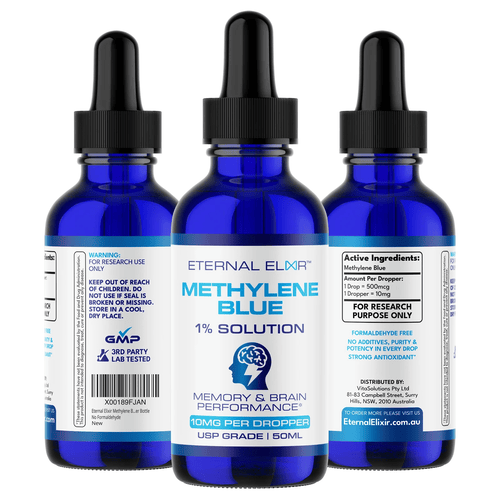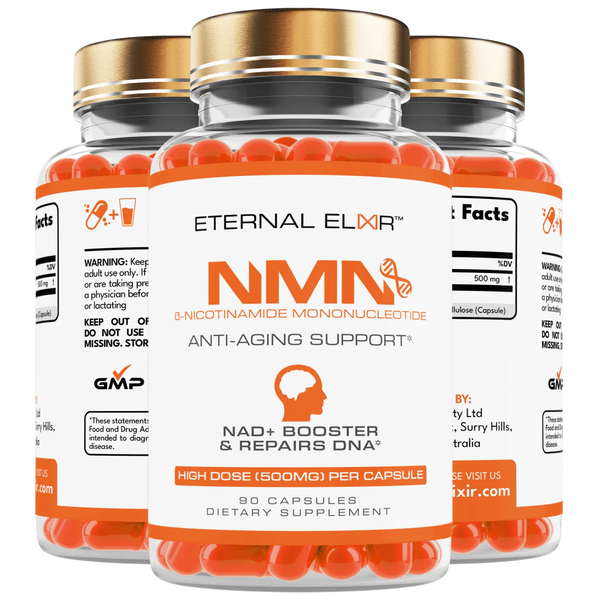A Comprehensive Guide To Methylene Blue

Methylthionine chloride, also known as methylene blue, has a fascinating history in both science and medicine. It’s been used since the 19th century, especially for the treatment of malaria. As of now, it has become quite an important antidote, especially for emergency medicine. What’s more fascinating about this salt is that it is now being used in neurology and anti-aging treatments, too.
Want to learn more about what is methylene blue? Stick along because this guide will answer all your questions in detail!
What Is Methylene Blue?
Methylene blue is a famous thiazine dye. It’s also known as a great redox-active compound that comes with a great potential to transfer electrons. Due to its characteristics, it’s considered quite valuable in both medical treatment and research. Most importantly, it’s used in hospitals to treat a very rare but serious condition called “methemoglobinemia” (hemoglobin loses the ability to carry oxygen around the body). In a nutshell, methylene blue carries quite a lot of significance, especially in the medical field.
When it comes to its use in research and biology, methylene blue is specifically used as an indicator or stain to study cells under a microscope. As it comes with properties like donating electrons, it has been widely studied in the context of oxidative stress and metabolism. However, as it’s a dye, one of the major side effects it comes with is that it can turn your bodily fluids, like urine and saliva, blue or greenish in color.

The Well-Established Role Of Methylene Blue In Medicine
Methylene blue is quite common in medicine. Here are two established roles it plays when it comes to the medical field;
Surgical and Diagnostic Use: In some medical procedures and surgeries, doctors use methylene blue as a dye or a mapping agent to mark specific tissues for easier identification, especially lymph nodes.
Treating Methemoglobinemia: Methylene blue plays a crucial role in treating methemoglobinemia. It’s a condition where the hemoglobin isn’t able to carry oxygen well. This is where methylene comes into action. It helps in restoring the normal function of the hemoglobin, improving oxygen supply in the body.
Experimental And Claimed Benefits Of Methylene Blue
Other than the established uses, methylene blue is being studied in the nootropics, anti-aging, and biohacking communities for broader applications. The benefits are yet to be studied, and as of now, they are all experimental and inconclusive.
As per evidence, here are some major claims by different communities regarding methylene blue benefits;
1-It Possesses Anti-septic And Anti-microbial Properties
In laboratory settings, methylene blue has shown some promising properties as an anti-septic and anti-microbial dye. It’s partially believable because it does have the capability to interfere with replication, and it can damage the microbial DNA. It’s still being studied whether it can help against viruses like COVID-19. However, there’s no clinical evidence yet. All these are just speculative benefits so it should not be used directly as an anti-septic inside the body.
2-Cognitive And Neuroprotective Effects
Methylene blue has been the talk of the town, especially for its positive effects on brain health, memory, and slow aging. Some pilot trials were performed on healthy volunteers, and they reported modest improvements after a single dose. Also, some other controlled trials suggested slight positive cognitive effects of methylene blue, but none are confirmed yet.
There have been other, more dramatic claims as well, like “methylene blue can help treat Alzheimer’s” or that it comes with “anti-aging effects”. These are all speculative claims, and none are properly supported in human trials. As per experts, not all evidence in cells and animals translates into effective and safe results in human beings.
3-Mood Enhancement And Anti-Depressant Effects
Methylene blue has also been studied for its mood enhancement and anti-depressant effects. The dye releases neurotransmitters in the brain, including dopamine and serotonin, which help regulate your mood. As per a study, daily use of methylene blue supplements led to antidepressant effects, especially in those who suffer from chronic depression. Moreover, it’s also effective for people with anxiety issues, especially those with bipolar disorder.
4-Helps Treat Fibromyalgia And Chronic Fatigue
Methylene blue therapy can work wonders for those struggling with both physical and mental energy. What happens is that it improves the mitochondrial function and also boosts your physical energy, leading to less fatigue. Mitochondrial dysfunction is quite common in metabolic disorders, chronic fatigue, and fibromyalgia, and that’s exactly what methylene blue fixes. Some individuals reported better focus and alertness after using methylene blue, which suggests that it does have potential benefits, especially for those who suffer from chronic fatigue.
Risks, Side Effects, And Safety Considerations When Using Methylene Blue
Methylene blue comes with strong biochemical effects, but at the same time, it carries a risk profile as well. Here’s a breakdown of all the risks, methylene blue side effects, and interactions that you should know about;
Discoloration of Bodily Fluid: One of the obvious side effects of methylene blue is that it can turn your urine, saliva, and stool blue. It’s a dye, so the discoloration isn’t really a shocking effect.
Serotonin Syndrome: It’s highly advised to use methylene blue in a medical setting, or else it can become life-threatening for you. Serotonin syndrome is another major side effect as methylene blue can inhibit the enzyme (MAO‑A). This enzyme can break down serotonin, and if combined with other antidepressants that increase serotonin, you could end up with serotonin syndrome, which is a life-threatening condition. The symptoms include high fever, confusion, agitation, and muscle rigidity as well.
Hemolytic Anemia: People with a deficiency of the enzyme G6PD should refrain from using methylene blue, as it can further cause the red blood cells in your body to break down, and it’ll eventually lead to anemia, fatigue, and dark urine.
Possible Allergic Reactions: Some people are allergic to methylene blue, and serious reactions like anaphylaxis can occur.
Kidney and Liver Concerns: People with liver or kidney disease should also refrain from using methylene blue, as it can become more risky due to impaired clearance.
Safety Considerations When Using Methylene Blue
Whether you want to use methylene blue in health or in a medical context, here are some important safety considerations you must keep in mind;
Ensure That You Are Using The Correct Form And Dosage
Methylene blue comes with different grades, and you first need to ensure that you are using the right one that’s suitable for consumption.
- Industrial or lab-grade methylene blue isn’t safe for human consumption as it contains toxic impurities like heavy metals.
- The pharmaceutical-grade methylene blue is safe for human consumption as it’s free from impurities.
As far as the dosage is concerned, you should always use methylene blue in low doses for cognitive purposes. Heavy doses are only used in hospitals to treat conditions like methemoglobinemia. Moreover, exceeding the normal dosage can become toxic for your health, and it can lead to life-threatening consequences.
Pregnancy And Breastfeeding Risks
Pregnant women shouldn’t use methylene blue as it can lead to birth defects, especially if they are in the second or third trimester.
It should also be avoided if you are breastfeeding because it can easily pass into your breastmilk, putting your child in danger.
Never Mix It With Recreational Drugs
You shouldn’t combine methylene blue with other recreational drugs and nootropics like MDMA, cocaine, or even high doses of caffeine. Doing so can lead to unpredictable and extremely dangerous consequences, especially if the drugs raise your dopamine or serotonin levels.
In a nutshell, using methylene blue without any medical supervision is dangerous. You need to use it in a medical setting with controlled dosage and complete knowledge of your health condition.
Legal Status Of Methylene Blue In Australia
“Is methylene blue legal in Australia?” Here’s a detailed explanation of how methylene blue is regulated in Australia:
- This chemical dye isn’t available legally over the counter for health or medical use. You can’t simply buy it off the shelf just to boost your brain health or for general well-being.
- You need a valid prescription from a professional practitioner in order to buy methylene blue. You can’t simply possess or use the dye for therapeutic intent without showing a proper prescription.
- Some imported unregistered methylene blue products are being sold with speculative and unapproved claims (brain boosting and anti-aging uses). As per the Therapeutic Goods Administration (TGA), none of these products have been assessed for their quality and safety under Australian law, and people should refrain from purchasing them.
- Due to TGA restrictions, it’s prohibited to use or market any methylene blue products without proper registration and prescription. If someone does so, they might have to face some serious legal consequences.
In simpler words, it’s illegal to use methylene blue Australia products without a prescription, and you cannot market them without proper registration and a license.
Bottom Line
You should not treat methylene blue as a casual supplement, as it’s a very powerful compound that’s still being studied for its benefits. All the claims and benefits you see around are mostly speculative and unconfirmed. Yes, it does have real medical uses, but if you are planning to self-medicate, know that the risks can outweigh the benefits, and it can turn really dangerous for you. You should consult your medical practitioner first and only use it if it’s really necessary.
FAQs
Q1. Is Methylene Blue Legal In Australia?
Yes, methylene blue is legal in Australia, but you can only get your hands on it with a proper prescription. It’s classified as a Schedule 4 medicine, which means that you can’t simply buy it over the counter without a doctor’s approval.
Q2. What Is Methylene Blue?
Methylene blue is a synthetic dye that’s been used in medicine for more than a century now. It’s used as a diagnostic dye, and it does treat a few blood disorders as well. Recently, it has gained attention as a potential anti-aging and brain-boosting supplement, but it’s all still in the experimental stage, and the claims are speculative.
Q3.How Many Drops Of Methylene Blue Should I Take?
You shouldn’t take any dosage of methylene blue without consulting your doctor. The right number of drops depends on your health condition, your body weight, and other medications that you are using. It’s highly advised to consult your doctor first, as taking any wrong amount can lead to dangerous consequences.
Q4. Where To Buy Methylene Blue In Australia?
You can’t legally buy methylene blue in Australia without a prescription. It’s not the kind of supplement you can purchase over the counter. First, consult your doctor or a licensed pharmacist!
Q5.How Many Drops Of Methylene Blue Per Day?
There’s no standard number of methylene blue drops. The dosage depends on multiple factors, including your weight, your health condition, the concentration of methylene blue, and medical supervision. Consult your doctor and only consume if really necessary!


